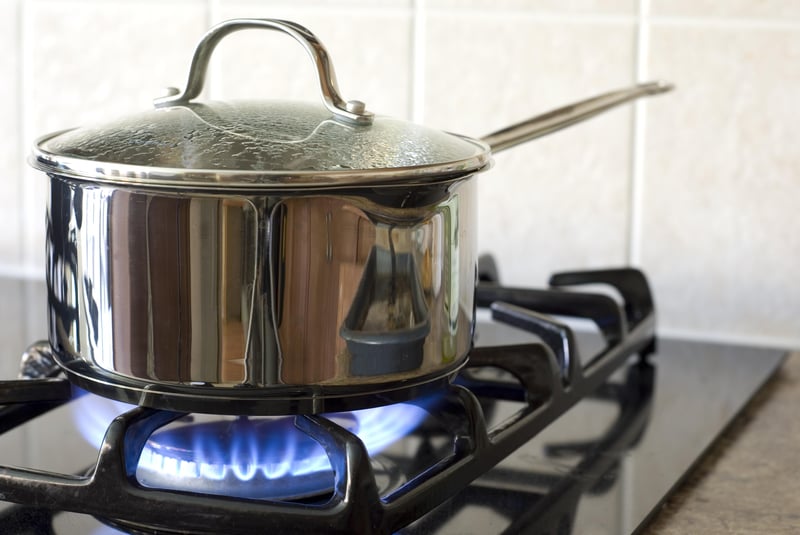Get Healthy!

- Dennis Thompson
- Posted June 16, 2023
Gas Stove Chemical Tied to Higher Risk of Leukemia
Using gas stoves can increase indoor air levels of benzene, a chemical linked to higher risk of leukemia and other blood cell cancers, a new study reports.
Analysis of dozens of stoves revealed that a single gas cooktop burner on high or a gas oven set to 350 degrees Fahrenheit can raise indoor levels of benzene above those typically released by secondhand tobacco smoke, the researchers reported.
Benzene emitted by gas stoves also can drift throughout a home and linger for hours, according to the study published June 15 in the journal Environmental Science & Technology.
More than one-third of U.S. households, some 47 million homes, cook with gas, researchers said in background notes.
"Benzene forms in flames and other high-temperature environments, such as the flares found in oil fields and refineries. We now know that benzene also forms in the flames of gas stoves in our homes,"said senior study author Rob Jackson. He is a professor of Earth system science at Stanford University's Doerr School of Sustainability.
"Good ventilation helps reduce pollutant concentrations, but we found that exhaust fans were often ineffective at eliminating benzene exposure,"Jackson added in a Stanford news release.
The researchers noted that the new study is the first to analyze benzene emissions when a gas stove or oven is in use.
Gas stoves have become something of a political football in recent months, after the U.S. Consumer Product Safety Commission (CPSC) announced that it would conduct a public review of the health hazards posed by the appliances.
"This is a hidden hazard," CPSC Commissioner Richard Trumka Jr., said in an interview in January. "Any option is on the table. Products that can't be made safe can be banned."
This prompted a backlash from conservatives, who accused the federal government of trying to ban gas stoves.
The Association of Home Appliance Manufacturers, which represents gas range manufacturers, countered at the time that all cooking produces emissions.
"Ventilation is really where this discussion should be, rather than banning one particular type of technology," said Jill Notini, a vice president with the Washington, D.C.-based trade group. "Banning one type of a cooking appliance is not going to address the concerns about overall indoor air quality. We may need some behavior change, we may need [people] to turn on their hoods when cooking."
Previous studies have focused largely on leaks from stoves when they are off, the Stanford researchers noted.
Unburned gas samples taken from 69 Boston-area cooking stoves contained at least 21 hazardous air pollutants, including benzene, toluene, ethylbenzene, xylene and hexane, according to a June 2022 study published in Environmental Science & Technology.
Further, about three-quarters of all recorded methane emissions from gas stoves occurring indoors happened while the stoves were off, according to a January 2022 report in Environmental Science & Technology.
"Your stove, regardless of when you use it, is always at a very low level leaking natural gas. This is what you're exposed to all the time, when there's this constant leak,"said Tasha Stoiber, a senior scientist with the Environmental Working Group in Washington, D.C.
But it's also known that burning natural gas also emits other pollutants like nitrogen dioxide and fine particulate matter that can exacerbate breathing problems, the researchers noted.
A 2013 meta-analysis concluded that children who live in homes with gas stoves had a 42% greater risk of asthma than children living in homes without gas stoves, and a 2022 analysis calculated that nearly 13% of childhood asthma in the United States is attributable to gas stoves, the researchers said in background notes.
For the new study, the investigators tested gas and propane stoves in 87 homes in California and Colorado. These included 54 gas burners set on high, 11 propane burners set on high, 47 gas ovens and 9 propane ovens.
The researchers found these burners and ovens emitted 10 to 50 times more benzene than electric stoves, while induction cooktops emitted no detectable benzene whatsoever.
Rates of benzene emitted during combustion tested hundreds of times higher than benzene from unburned gas leaking into homes, the study authors added.
The investigators also tested whether foods emit benzene while being cooked, and found zero benzene emissions from pan-frying salmon or bacon. All benzene emissions the research team measured came from the gas or propane, rather than from food.
"I'm renting an apartment that happens to have an electric stove,"said lead researcher Yannai Kashtan, a Stanford graduate student in Earth system science. "Before starting this research, I never thought about it twice, but the more we learn about pollution from gas stoves, the more relieved I am to be living without a gas stove."
The research team said that people can reduce their exposure to pollutants from gas stoves by using a range hood and opening windows while cooking. Other strategies include:
- Using a portable countertop hotplate
- Use electric kitchenware, such as tea kettles, toaster ovens and slow cookers
- Replacing gas appliances, using federal tax credits and rebates or low-interest loans offered by some states and cities
More information
Harvard Medical School has more about improving indoor air quality and gas stoves.
SOURCES: Environmental Science & Technology, June 15, 2023; Stanford University, news release, June 16, 2023







